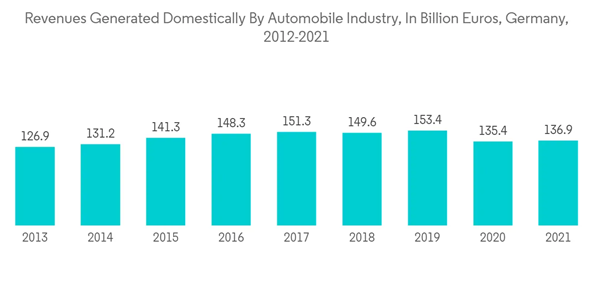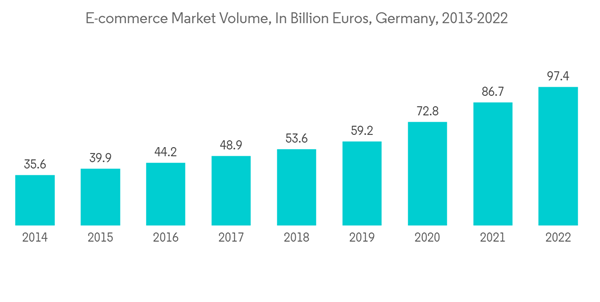The Germany Third-Party Logistics Market size is estimated at USD 44.92 billion in 2024, and is expected to reach USD 53.18 billion by 2029, growing at a CAGR of 3.43% during the forecast period (2024-2029).
Germany is the world's premium car production hub. Of all premium branded vehicles produced globally, 65% are German OEM-manufactured. Of all vehicles produced globally, 40% of vehicles were produced in Europe - of which 23% were made in Germany in 2021. Within Europe, more than 80% are German OEM-badged vehicles - 57% of these vehicles were made in Germany. The western European light vehicle production sector is a predominantly premium sector focused.
German vehicles were mainly exported to European countries. Other leading regions for vehicle export included North and South America, as well as Asia. The list of leading import countries for German motor vehicles included the US, the UK, and China among the top three. The country exports EUR 20-25 billion worth of cars to the US.
Volkswagen, BMW, and Daimler occupy the top three slots, with suppliers including Bosch, Schaffler, and ZF also coming out top internationally. The industry plans to invest EUR 150 billion in digitalization, electric mobility and drive systems, hydrogen technology and transport safety in the coming years.
In 2021, total sales amounted to USD 127.5 billion, which translated to a 24% growth compared to 2020. It is expected that the online population in Germany will increase from 62.4 million in 2020 to 68.4 million in 2025. E-commerce penetration in 2021 reached 77% in the German market.
As a result of strict COVID lockdown measures throughout 2020 and 2021, many German consumers increased their online purchases and bought goods like groceries and sanitary items online for the very first time. Key reasons for consumers to shop online include home delivery, 24/7 availability, and convenience.
This product will be delivered within 2 business days.
Key Highlights
- As Germany is a regional hub, it is a preferred location for manufacturers who can have support from the ecosystem of leading shippers and third-party logistics providers (3PLs) in the country. The demand for warehousing space has expanded in the past decade, and over the forecast period, it is expected to be boosted by growth in regional trade and e-commerce.
- E-commerce is one of the major factors driving the market growth. The country has been among the top five revenue generating through e-commerce. The emergence of e-commerce in recent years has boosted the growth of the 3PL market. Given the increasing domestic market, and the projected greater efficiencies in inventory forecasting and stock management, the need for warehouse supply is expected to moderate in the future.
- Not only is Germany's logistics infrastructure world-class, but its companies are also global logistics leaders. In fact, the world's largest logistics service provider is a German company - Deutsche Post (DHL). Deutsche Bahn operates Europe's largest rail network, and Lufthansa Cargo is one of the world's leading global air freight companies.
- With the onset of COVID-19, the 3PL logistics market saw an upward trajectory, with the increase in demand coming especially from the e-commerce sector.
Germany Third-Party Logistics (3PL) Market Trends
Growth in the Automotive Sector to Drive the German 3PL Market
The automotive sector is the backbone industry in Germany, and the German automotive sector is a global leader.Germany is the world's premium car production hub. Of all premium branded vehicles produced globally, 65% are German OEM-manufactured. Of all vehicles produced globally, 40% of vehicles were produced in Europe - of which 23% were made in Germany in 2021. Within Europe, more than 80% are German OEM-badged vehicles - 57% of these vehicles were made in Germany. The western European light vehicle production sector is a predominantly premium sector focused.
German vehicles were mainly exported to European countries. Other leading regions for vehicle export included North and South America, as well as Asia. The list of leading import countries for German motor vehicles included the US, the UK, and China among the top three. The country exports EUR 20-25 billion worth of cars to the US.
Volkswagen, BMW, and Daimler occupy the top three slots, with suppliers including Bosch, Schaffler, and ZF also coming out top internationally. The industry plans to invest EUR 150 billion in digitalization, electric mobility and drive systems, hydrogen technology and transport safety in the coming years.
Increasing Demand for E-commerce Fulfillment Services
The 3PL logistics sector is restless, seeing the growing demand for logistics services generated by the boom and evolution of e-commerce. Germany has one of the largest e-commerce markets in Europe. The number of e-commerce consumers, internet penetration, and the average amount spent per year are all above the European average.In 2021, total sales amounted to USD 127.5 billion, which translated to a 24% growth compared to 2020. It is expected that the online population in Germany will increase from 62.4 million in 2020 to 68.4 million in 2025. E-commerce penetration in 2021 reached 77% in the German market.
As a result of strict COVID lockdown measures throughout 2020 and 2021, many German consumers increased their online purchases and bought goods like groceries and sanitary items online for the very first time. Key reasons for consumers to shop online include home delivery, 24/7 availability, and convenience.
Germany Third-Party Logistics (3PL) Industry Overview
The market is relatively fragmented, with the presence of a large number of local and international players, including Dachser, DB Schenker, DHL Supply Chain, Fiege Logistics, and Havi. While the country is undergoing regulatory changes, the 3PL market is experiencing expansions, mergers, and acquisitions, increasing its grasp over the national and international markets.Additional Benefits:
- The market estimate (ME) sheet in Excel format
- 3 months of analyst support
This product will be delivered within 2 business days.
Table of Contents
1 INTRODUCTION
2 RESEARCH METHODOLOGY
4 MARKET INSIGHTS
5 MARKET SEGMENTATION
6 COMPETITIVE LANDSCAPE
8 APPENDIX
Companies Mentioned (Partial List)
A selection of companies mentioned in this report includes, but is not limited to:
- Deutsche Post DHL
- DB Schenker
- Dachser
- Hellmann Worldwide Logistics
- WemoveBW GmbH
- Helm
- Honold
- Havi
- FIEGE Logistics
- Kuehne + Nagel
- APL Logistics
- Rigterink Logistics
- Ziegler Logistics Deutschland*
Methodology

LOADING...










